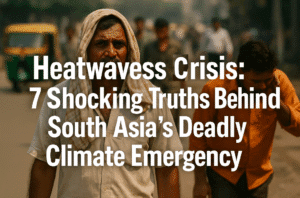Heatwaves Crisis: 7 Shocking Truths Behind South Asia’s Deadly Climate Emergency
South Asia faces a climate reckoning as record-breaking heatwaves scorch India and Pakistan months earlier than usual, with temperatures exceeding 45°C (113°F) in April—a grim preview of a “new normal.” Scientists attribute the intensifying heat to human-driven climate change, with urban areas like Delhi now up to 4°C hotter than pre-1986 levels. Marginalized communities—construction workers, street vendors, and farmers—bear the brunt, lacking access to cooling or healthcare, while overtaxed power grids fail under surging demand.
Cities, trapped in concrete heat islands, amplify risks, and half-measures in heat action plans leave millions vulnerable. Global parallels emerge, from Spain to the Middle East, as climate models underestimate the speed of collapse. Solutions—equitable adaptation, green urban design, and rapid fossil fuel phaseout—are urgent but unevenly adopted. The crisis underscores a harsh truth: survival now hinges on systemic change, not just survival tactics. Without radical emission cuts and global solidarity, heatwaves will redefine livability, not just seasons.

Heatwaves Crisis: 7 Shocking Truths Behind South Asia’s Deadly Climate Emergency
As spring barely settles across South Asia, a brutal wave of early heat has shattered norms, exposing a region grappling with a climate emergency. Temperatures in India and Pakistan have surged past 45°C (113°F) in April—months before summer’s peak—forcing schools to close, overwhelming hospitals, and pushing vulnerable communities to the brink. This isn’t an anomaly; it’s a dire preview of a hotter future where survival hinges on urgent action.
The Human Toll of Relentless Heat
In Delhi, rickshaw drivers wrap wet scarves around their heads, construction workers ration water breaks, and hospitals report a surge in heatstroke cases. Meanwhile, in Pakistan’s Sindh province, farmers toil under 50°C (122°F) skies, their livelihoods evaporating with each scorching day. For the 1.9 billion people in South Asia, extreme heat isn’t just uncomfortable—it’s life-threatening. Over 60% of India’s workforce labors outdoors, with no access to cooling shelters or healthcare. “We work until we collapse,” says a Jaipur construction worker, echoing a sentiment felt across the region.
Climate Change Accelerates the Crisis
Scientists confirm what thermometers scream: human-driven climate change has turbocharged these heatwaves. A recent ClimaMeter analysis found similar weather patterns now produce temperatures up to 4°C hotter than pre-1986 levels. “What we once called ‘extreme’ is now baseline,” says climate scientist Gianmarco Mengaldo. Urbanization worsens the crisis—concrete jungles like Delhi and Karachi trap heat, making cities 3°C hotter than rural areas. Even El Niño, a natural climate cycle, isn’t to blame this time; the culprit is unequivocally fossil fuels.
A Failure of Preparedness
Despite dire warnings, adaptation efforts lag. Pakistan’s Dawn newspaper laments the country’s “woeful unpreparedness,” while Delhi’s heat action plans—like cooling centers and hydration stations—remain inconsistently implemented. Power grids buckle under demand for AC, triggering blackouts that leave millions sweltering in darkness. “Without resilient infrastructure, heatwaves become mass casualty events,” warns researcher David Faranda.
Lessons from the Frontlines
Innovative solutions exist but are unevenly adopted:
- Ahmedabad, India: After a 2010 heatwave killed 1,300, the city launched South Asia’s first heat action plan, using rooftop solar panels and early warning systems to cut deaths by 30%.
- Singapore: Green corridors and reflective building materials reduce urban heat islands, a model others could replicate.
- Rural Pakistan: Ancient karez irrigation systems are being revived to combat drought, blending tradition with climate resilience.
Yet such measures are often inaccessible to the poorest. Street vendors, day laborers, and small farmers—already marginalized—bear the brunt. “Adaptation isn’t just technology; it’s equity,” says Mengaldo.
The Global Warning
South Asia’s plight mirrors a worldwide pattern. Spain and France brace for unprecedented summer temperatures, while the Middle East faces conditions “incompatible with human life.” Climate models, experts admit, underestimated how quickly thresholds would be breached. “Events predicted for 2050 are here now,” says Faranda. The cost of inaction? A future where surviving summer requires radical lifestyle shifts—reduced energy use, heat-resistant architecture, and a phaseout of fossil fuels.
A Path Forward
- Rapid Decarbonization: Slashing emissions remains non-negotiable. Every fraction of a degree matters.
- Equitable Adaptation: Invest in affordable cooling, green urban design, and healthcare for vulnerable groups.
- Global Solidarity: Wealthy nations must fund climate resilience in the Global South, where impacts are fiercest and resources scarcest.
The Bottom Line
South Asia’s heatwaves are a wake-up call: climate change isn’t a distant threat but a present emergency. Surviving this era demands more than air conditioning—it requires reimagining how we live, work, and share resources. As temperatures soar, the question isn’t just how to stay cool today, but how to secure a livable tomorrow. The time for half-measures is over; the new normal leaves no room for delay.
You must be logged in to post a comment.